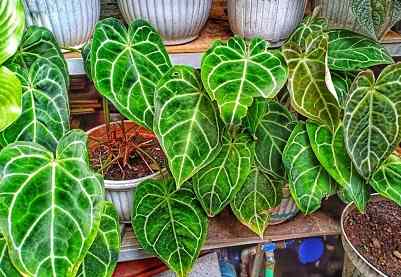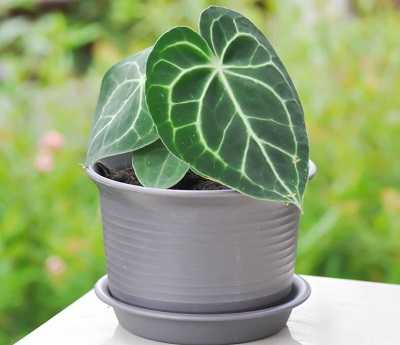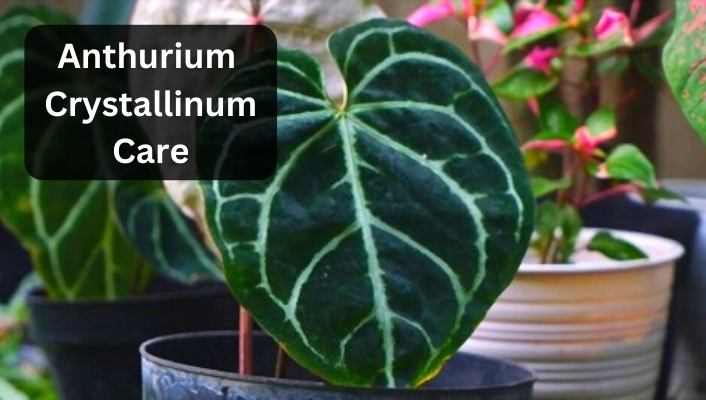Anthurium Crystallinum is a species of tropical flowering plant. They are native to Central and South America rainforest margins, from Panama to Peru.
Moreover, they are prized for their gorgeous ornamental leaves. The leaves of Crystallinum are large, velvety, heart-shaped, and covered with prominent white veins. Along with the inflorescences, which have green spathes and pale green spadices throughout the year.
Crystallinum is easy to take care of compared to other plants, making them favorable for many houseplant lovers. They grow to about 90 cm (35 in) tall and broad. It is an epiphytic perennial or “air plant.” It derives most of its nutrients from the air, rain, and debris around it.
Getting into the main part of the article, we have summarized the essential caretaking points for the Anthurium Crystallinum. So, if you are planning on getting one or have one, this guide is the thing you are finding.
Post Contents
- Anthurium Crystallinum Quick Info:
- Taking Care of the Anthurium Crystallinum:
- Light Needs of the Plant:
- Watering the Plant Correctly:
- Temperature Requirements:
- Soil or Potting Mix for the Anthurium Crystallinum:
- Fertilizing the Plant Properly:
- Repotting of Anthurium Crystallinum:
- Pruning:
- Propagation of Anthurium Crystallinum:
- Anthurium Crystallinum Care in a Nutshell:
- Frequently Asked Questions:
- Conclusion:
- Author
Anthurium Crystallinum Quick Info:
| Property | Description |
|---|---|
| Common Name | Anthurium Crystallinum |
| Family | Araceae |
| Genus | Anthurium |
| Species | Crystallinum |
| Origin | Tropical regions of Central and South America |
| Light Requirement | Bright, indirect light |
| Temperature | 65-85°F (18-29°C) |
| Humidity | High (60-80%) |
| Watering | Keep soil evenly moist but not soggy |
| Fertilizer | Balanced liquid fertilizer monthly |
| Potting Mix | Well-draining, rich in organic matter |
| Toxicity | Toxic to humans and pets |
Taking Care of the Anthurium Crystallinum:
Before moving on to the in-depth discussion about the care of this beautiful and extraordinary plant. First, let’s talk about the crystallinum’s very basic care requirements:
- You can either give it bright, indirect light or bright, filtered light
- Keep it consistently moist
- Use a well-draining, loose potting soil mix that holds some moisture
Now keep reading on for a full care guide!
Light Needs of the Plant:
Provide your Anthurium crystallinum with bright light, but it doesn’t hit it directly. This is because they love bright light, but they grow naturally in environments where they would still be receiving some shade. Direct light can destroy the foliage of your plant.

Now, in your opinion, you can also use grow lights. They are a great option if you don’t have enough light to keep your plant happy.
Talking about the duration of light needs, This plant prefers bright indirect light for around 12-16 hours daily. All you have to do is replicate its native habitat. That is the equator, where days are long.
Related Post: Calathea Ornata Care Guide
Watering the Plant Correctly:
Anthurium crystallinum should always remain moist. An important point for your information is that MOIST does not mean WET. Let’s understand this. Moist soil has a little humid wateriness, whereas wet soil has large amounts of water.
Anthurium crystallinum thrives in above-average humidity. It is best to replicate its natural environment of tropical rainforests, where it is always moist.
During the growing season, keep the top inch of the soil moist. Water the plant regularly, especially during summer. Never allow the soil mix or growing medium to dry out.
Talking about areas with humid weather, the plant can survive without water for up to two weeks. A secret for healthy plants is distilled water instead of tap water. Tap water has many minerals that can slow the growth of plants.
Temperature Requirements:
Moving onto the temperature requirements, this plant can grow well in normal household temperatures. But usually, it prefers warmer temperatures.
It thrives in a warm temperature range of 65-80 degrees Fahrenheit (18-26 degrees C). You should keep your plant above 55 degrees Fahrenheit at all times.
Keep your beautiful plant away from open windows and vents in winter. These plants can easily cope with changes. Somehow manage a constant temperature for your Anthurium.
For a quick recap, putting them in a warm area with humid air is best.
Soil or Potting Mix for the Anthurium Crystallinum:
As we all know, epiphytes need not be tightly packed into the soil. Instead, they need a well-draining, loose potting mix that holds some moisture.
Now, this might sound a bit anonymous! But the main thing is that the potting mix needs to keep some moisture and get rid of most of the water.

For making your own potting/soil mix, we recommend a soil mixture with one part perlite, one part coconut coir, one part sand, one part peat moss, one part pine bark, two parts orchid mix, and a few handfuls of compost.
This mixture will be quite airy and will keep your Anthurium roots to be able to breathe well.
Related Article: Plants With Heart Shaped Leaves
Fertilizing the Plant Properly:
To fertilize this plant, a diluted liquid orchid fertilizer high in phosphorus is great. A basic slow-release or balanced houseplant fertilizer can work well too. Use the fertilizer monthly during the growing season (spring and summer).
Similarly, you can give your Anthurium some crushed organic matter about once a month to help with healthy and balanced growth. Again, this is copying its native environment because that’s how its epiphytic roots would receive nutrients in the rainforest. Plants can benefit from the addition of compost as a nutrient source.
Repotting of Anthurium Crystallinum:
The plant is a relatively slow grower, so you won’t need to repot it frequently. Instead, repot this plant when it becomes rootbound. Signs that a rootbound has occurred and you should consider repotting the plant include:
- Roots coming out of the pot’s drainage holes
- Testing if the roots are coiled around the bottom of the pot or the outside of the soil by taking the plant out of its pot.
- Stunted growth and a general sad-looking plant
Use a pot with good drainage that is the next size up from the current pot when repotting. When possible, repot plants in the spring and summer when they are growing.
Pruning:
The crystallinum does not need proper pruning, but you should always keep checking and removing any dead or dying leaves.
Propagation of Anthurium Crystallinum:
The easiest way to propagate this plant is by simply dividing a plant growing in the same pot.
Slowly take the entire plant out of its pot and identify a piece with its root system. Make sure the piece has at least one leaf, but the more, the merrier.
Separate the root systems but be careful not to damage the roots. This can be done by hand, with a pair of clean, sharp scissors to cut the roots away from each other.
Set the new plants gently in appropriately sized pots. Never use big pots because they can lead to water clogging.
Water the plants and care for them how you normally would. A break would occur in growth, but soon they will grow normally.
The best recommendation is to do this during the growing season (spring and summer.
Anthurium Crystallinum Care in a Nutshell:
- Give it bright but indirect light for long periods
- Always keep it moist
- Provide it with humidity and warm temperatures
- It is best to use a loose, well-draining potting mix that retains some moisture
- Use a balanced houseplant fertilizer, always in diluted form
- Repot when growth slows down, or rootbound occurs
- Remove any dead or dying leaves and clean, fresh leaves
Frequently Asked Questions:
Does Anthurium crystallinum need a lot of care?
These plants don’t require too much care. But the most important thing to care for is the right indoor temperature and cleaning routine.
What are the levels of humidity best for Anthurium crystallinum?
Ideal humidity levels for Anthurium Crystallinum are mostly between 70 and 80 %. Make sure the plant is provided with constant humidity.
Can Anthurium crystallinum be misted and kept wet?
Maintaining a high humidity level is desired. You can mist your plants with water daily. But don’t make the leaves too wet for too long otherwise, the fungus will start to build on the leaves in the form of leaf spots.
Is Anthurium crystallinum a climbing plant?
It has aerial roots that love to climb on trees in its native rainforests. Indoors, it grows well on a moss pole, which can give this large-leafed plant the support it needs.
Conclusion:
Anthurium crystallinum is a popular plant for indoor gardening, thanks to its beautiful, intricately veined leaves. Tropical beauties are easy to take care of and can easily be added to your plant collection. Make your decor levels higher as well.
We hope you got all the necessary information that you were looking for. You can easily get an Anthurium plant and care for it with expertise.
Some Other Related Articles You Must Read!
Monstera Siltepecana Care & Growing Guide

